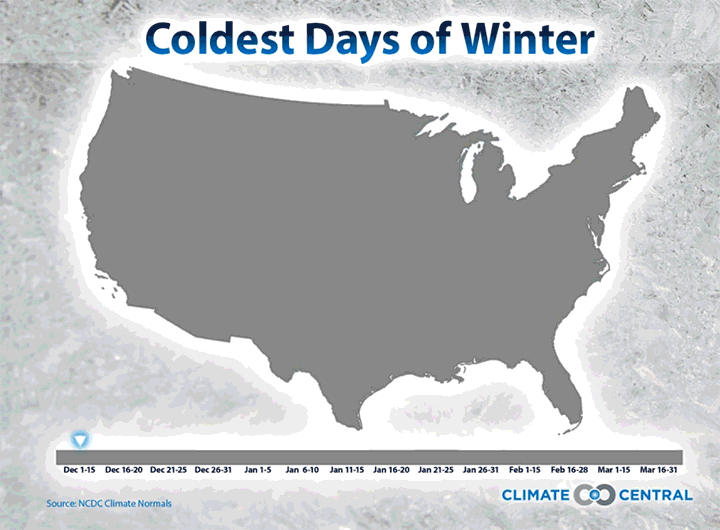News•January 8, 2015
Find Out When the Coldest Day Usually Hits Your Town
By Climate Central
Two blasts of Arctic air are reminding tens of millions of Americans this week of just how cold winter can get, even in a world where temperatures are getting steadily warmer on average. The coldest air so far this season will keep daytime highs below zero in the Upper Midwest and no higher than the 30s even as far south as Atlanta.
Click here for a static image.

But will it be the coldest air of the winter? Statistically speaking, not necessarily for some of these areas. As the national map above shows, the coldest time of year, based on the 1981-2010 climate “normals,” can come as early as mid-December in parts of the West and Southwest; in mid-January across much of the Southeast and anywhere from late January to mid-February — and even late February in some spots — in much of the Upper Midwest and Northeast. You can see for yourself what week usually brings the coldest weather to your city using the drop-down menu below.
Check out when the big chill generally hits your city:

Why the difference? One major reason, according to NOAA, is snow cover: places that tend to have the most, including the Northeast and Upper Midwest as well as some high-altitude regions in the West, reflect the most sunlight back into space — sunlight that would otherwise tend to warm the ground somewhat. Winter snow cover is actually increasing in North America, but the trend isn't significant. In comparison, spring snow cover is declining significantly. What both those trends mean for when the coldest day of the year hits in a given location isn't entirely clear, though.
These are the averages, but conditions in any given year can stray from the average in either direction. So while Wisconsin’s coldest days tend to come a couple of weeks from now, this week could end up being the coldest period this time around (or maybe the worst is yet to come). In Oregon, the coldest days should have been here and gone already — but that’s only an average.
This year, as always, could be different.
You May Also Like:
U.S. Hot Streak Now Old Enough to Vote
Clock Is Ticking on Elusive El Niño Event
EPA Moves to Count Methane Emissions from Fracking
EPA Chief: Weather, Climate Scientists’ Work Is ‘Essential’